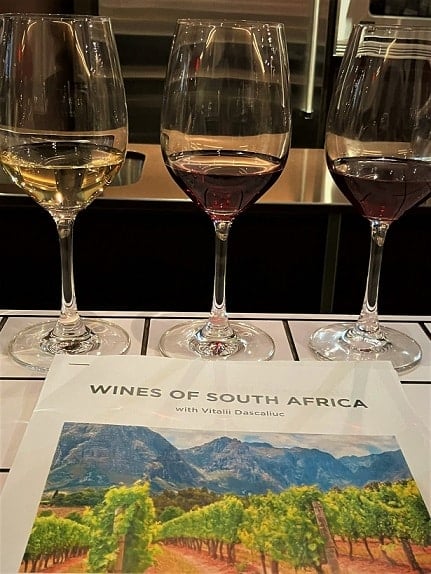South African workers in the wine sector were fighting against poor working conditions for farm workers at several vineyards in the country and the wine retailers were supporting their actions.
According to the Human Rights Watch (HRW), wine and fruit farm workers in South Africa live in on-site housing unfit for occupancy, are exposed to pesticides without appropriate safety equipment, have limited (if any) access to toilets or drinking water while working and have many barriers to representation by unions.
Economic Asset
Farm workers add millions of dollars to the economy of South Africa; however, the people who produce the goods are among the lowest wage earners in the country. According to the Paris-based Organization of Vine and Wine (OVI, 2021) data, South Africa ranked eighth among the world’s largest wine-producing countries, ahead of Germany and Portugal, behind Australia, Chile, and Argentina.
The wine industry in the Western and Northern Cape contributes R550 billion (approximately US $30 billion) to the local economy and employs almost 269,000 people. The annual harvest produces approximately 1.5 million tons of crushed grapes, producing 947+/- million liters of wine. Domestic sales record 430 million liters of wine; export sales total 387.9 million liters.
There are 546+/- listed wineries in South Africa with only 37 crushing over 10,000 tons of grapes (producing 63 cases of wine per ton; 756 bottles per ton). Most of the wine produced is white (55.1 %) including Chenin Blanc (18.6 %); Colombar(d) (11.1 %); Sauvignon Blanc (10.9 %); Chardonnay (7.2 %); Muscat d’Alexandrie (1.6 %); Semillon (1.1 %); Muscat de Frontignan (0.9 %); and Viognier (0.8 %).
Approximately 44.9 % of South African vineyards produce red varietals including Cabernet Sauvignon (10.8 %); Shiraz/Syrah (10.8 %); Pinotage (7.3 %); Merlot (5.9 %); Ruby Cabernet (2.1 %); Cinsau (1.9 %); Pinot Noir (1.3 %) and Cabernet Franc (0.9 %).
It is interesting to note that although South Africa is a recognized producer of fine wine, the alcoholic beverage of choice among South Africans is beer (75 % of total alcoholic beverage consumption), followed by alcoholic fruit beverages and spirit coolers (12 %). Wine consumption accounts for only 10 %, with spirits coming in last at 3 %.
Preferred Grapes
White Wines
Chardonnay accounts for 7.2 % of all vineyard plantings. Chardonnay tends to be medium-bodied and structured; however, some producers prefer to make Old World style (heavy and wooded), while others select a New World approach (lighter and unoaked).
The Chenin Blanc grape was one of the first wine grape cultivars introduced to the Cape by Jan van Riebeek (17th century). It has high acidity making it a versatile grape for producing a variety of wine styles from still, dry, and sparkling to well-balanced sweet wines. It is high-yield, versatile, and grows on land unsuitable for other white grape varieties.
The Colombar(d) varietal was planted in South Africa in the 1920s and is now the second most planted grape in the country. It was primarily used as a base wine for brandy production until the end of the 20th century when Cape Winemakers discovered it could produce a pleasant drinking wine with good acid content ensuring a fresh, fruity, and interesting palate experience. It was developed from a crossing of Chenin Blanc with Heunisch Weiss (aka Gouias Blanc).
Sauvignon Blanc presents as a crisp and refreshing wine. The first records in the Cape date to the 1880s; however, a high rate of disease led to most vineyards being ripped out and replanted in the 1940s. This variety is the third most planted white wine in South Africa and styles run from green and grassy to light and fruity.
Red Wines
Cabernet Sauvignon was first recorded in South Africa in the late 1800s. By the 1980s it made up 2.8 % of all vineyards; now it is found in 11 % of vineyards. The varietal produces very good wines that develop well with age and mature into a spicy, full-bodied, complex taste experience. The wines range from intense with perfume aromas, spicey and herbaceous on the palate, or soft and well-rounded with berry notes. It is also found in Bordeaux-style blends.
Shiraz/Syrah dates back to the 1980s. It is the second most planted red grape variety representing 10 % of plantings sparked by the Australian Shiraz popularity in the 1980s. Styles present as smokey, and spicey developing over time; frequently used in Rhone-style blends.
Merlot began as a single-hectare vineyard in 1977 and has increased to be found in approximately 6 % of red wine vineyards. It ripens early, is thin-skinned, and is highly sensitive to drought making growth and production challenging. Traditionally used in Rhone-style blends to add softness and breadth to Cabernet Sauvignon, increasingly it is bottled as a single varietal that is usually medium to light-bodied in style with a touch of herbal freshness.
Pinotage is a South African cultivar created by Professor Abraham Perold in 1925 and is a cross between Pinot Noir and Hermitage (Cinsault). Currently, it can be found in approximately 7.3 % of the vineyards. Pinotage is unpopular in export markets but a favorite in the country. The grapes can produce complex and fruity wines as they age but are pleasantly drinkable while young. Pinotage easy drinking styles produce rose and sparkling wines. It is the main component in Cape blend making up 30-70 % of the wine sold in South Africa.
Exports
In 2020, approximately 16 % of the wine produced was exported (480 million liters). The level was reached because of increased demand from African markets and the industry’s strategy to grow exports. There has been growth in wine exports to other African countries from 5 % in 2003 to 21 % in 2019. This is expected to continue as the African Continental Free Trade Agreement (passed in 2021) is implemented and becomes operational (2030). The member nations present a potential market of 1.2 billion people and a combined gross domestic product of $2.5 trillion. It is the end result of many negotiations started in 2015 among the leaders of 54 African nations.
South Africa has a free trade agreement with the EU and exports to the US via a duty-free agreement under the Africa Growth Opportunity Act (AGOA. The largest export is bulk wines and the EU is the biggest market.
Organizations representing the wine industry include:
• South African Liquor Brand Owners Association (SALBA). Manufacturers and distributors of liquor products on issues of common interest (i.e., lobbying the government on regulatory matters).
• South African Wine Industry Information Systems (SAWIS) supports the wine industry through the collection, analysis, and dissemination of industry information; administration of the industry’s Wine of Origin system.
• VINPRO. Wine producers, cellars, and industry stakeholders on issues that impact the profitability and sustainability of members and the entire industry (i.e., technical expertise, specialized services from soil science to viticulture, agricultural economics, transformation, and development).
• Wines of South Africa (WOSA). Represents producers of wine who export their products; recognized by the government as an Export Council.
• Winetech. Networking of participating institutions and individuals supporting the South African wine industry with research and technology transfer.
A Step into South African Wine
At a recent New York Astor Wine Center South African wine program, I was introduced to a number of interesting wines from South Africa. A suggestion for phasing into the world of South African wines includes:
• 2020. Carven, the Firs Vineyard, 100 % Syrah. Age of vines: 22 years. Viticulture. Organic/sustainable. Aged 10 months in neutral 5500L French tonneau (barrel; thin with a capacity of 300-750 liters). Stellenbosch.




